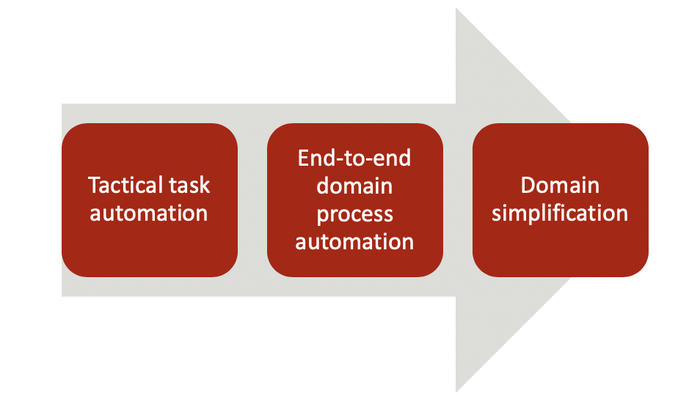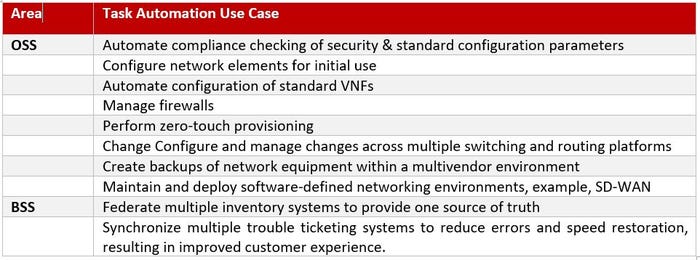Modernization of OSS/BSS with Open Source: Part 2: Automation
December 5, 2019

By Dr. Mark H Mortensen & Liliane Offredo-Zreik, ACG Research
This article is sponsored by Red Hat
This is the second article of a four-part series. In the first, we described how open-source software can speed the evolution of the OSSs and BSSs to a modern cloud-native containerized microservices-based architecture. In this paper and in the companion webinar, we describe how open source can be used to automate business, network and IT to provide initial quick hits that rapidly bring value to a CSP and, eventually, lead to fully automated operations.
INTRODUCTION
Communications Service Providers (CSPs) must transform their service delivery and management infrastructure to remain competitive. At the forefront of this transformation is the modernization of the systems that enable the management of network services, the operations support systems (OSS) and the systems for managing the customer and the overall business operations, the business support systems (BSS). Modernization of these systems is essential for business imperatives today: agility, elastic capacity scaling, and service velocity.
The modernization of the OSS and BSS has three main imperatives:
Cloud-native platform for both development and operations
Integration architecture to coordinate disparate systems and hybrid environments, thus enabling iterative transformation
Automation of the business, network and IT
THE IMPORTANCE OF AUTOMATION IN OSS AND BSS MODERNIZATION
Legacy OSS and BSS are inadequate for the needs of the modern CSP because they were primarily designed to assist the humans in executing the processes that ran the business. To support the modern CSP, these systems need automation and orchestration to operate the business quickly and autonomously under the control and oversight of people. This requires the CSP to define a roadmap to ultimately automate all the processes that run the business and manage the network.
Automation is not new; it has been around since computers were brought into the CSPs’ operations in the 1950s. What is new is the need to automate all the processes end-to-end and to enrich the automation of changes in the systems themselves as they evolve to meet new business needs.
Automating business processes to drive business agility
Basic consumer business operations, where transaction volumes are large and the tasks relatively simple, have already been automated to a great extent. Today, customers expect self-service and a great overall digital experience. To meet these demands, CSPs are introducing and modifying services and operations at an unprecedented speed. Supporting this new normal necessitates increased automation in product life-cycle management and a fundamental redesign of the BSS that manages services and customer experience.
Automating processes for business services is inherently complex because they require human involvement in analyzing needs, mapping to available services, quoting the services during the sales process (taking into account what the business customer already has or will have), and installing, configuring and supporting the services on an ongoing basis. Thus, there is much opportunity for reducing cost, friction, and time in this area.
Automating network management processes to increase agility and reduce cost
Network management processes are very labor intensive. Specialized technicians are needed to plan and order a wide variety of equipment, install it, configure it. They must configure services on the equipment (driven by service orders) and ensure that the configuration information is up to date on an ongoing basis. Technicians usually accomplish this with command line interfaces (CLI), supported by spreadsheets, configuration playbooks, and some automation and orchestration tools either from vendors or purpose-built by the CSP. These processes must be streamlined and eventually replaced by fully automated, intelligent and self-managed processes under the oversight of humans.
Network and OSS/BSS modernization also requires a new type of automation
As digital transformation changes how CSPs deploy and manage network functions and how they deliver services, automation has a new requirement: to automate (or orchestrate) the instantiation of the right software in the right container on the right computing and storage infrastructure at the right time, dynamically connected with other software systems. As software-based functions and services become more ubiquitous, more automation and overall orchestration is needed to control operational costs and to deliver the speed that is essential for the CSP operations.
Journey to a closed-loop automated environment
Re-engineering processes is a long-term journey and must be undertaken in steps to reap short-term benefits but done in the context of a well-defined, adequately thought-out long-term architecture. This iterative process is essential to minimizing business impact and to ensuring that the transformation is adaptable to changing business needs and technology evolution. Furthermore, the automation journey should proceed in steps of increasing complexity, starting with automation at the isolated task level, then at the domain level, and finally, when all domains have been automated, simplifying the domain structure itself. This process, depicted in Figure 1, has been proven most effective.

Figure 1. OSS/BSS Automation Journey
Step 1: Tactical Task Automation
The first step is to find tasks to automate that can bring immediate benefit. Some of these are in the business area (BSS), but many more are in the network management area (OSS). In task automation, existing checklists of manual processes are automated using Robotic Process Automation techniques. Simply put, these are sets of processes with minimal branching and looping that perform repetitive tasks. Red Hat Ansible[1] Automation is an open-source solution that has been shown to be particularly effective in doing this. Examples of quick-hit task automation are shown in Table 1.
Step 2: End-to-End Domain Process AutomationTable 1. Sample Task Automation Use Cases
Once the individual tasks have been automated, CSPs can automate more sophisticated processes end-to-end. This requires automation software that uses business process model and notation, decision model and notation, a complex event processing engine and a constraint-based optimization engine. These can be found in open-source solutions such as the Red Hat Process Automation Manager[2] and the Red Hat Decision Manager[3].
For BSSs, the domains can be customer types, for example, consumer and business. Further breakdowns into service types are customary: for consumers domains can be voice, video, and data and for businesses they can be segment-targeted services, such as SD-WAN for enterprise.
For OSSs, the domains follow technology lines, such as optical transport, radio networks, IP transport, SD-WAN, IP-VPNs, and IoT end-point devices, and sometimes these domains are further broken down into islands for each vendor.[4]
Typical automation use cases at the domain level are shown in Table 2.

Step 3: Domain Simplification and OptimizationTable 2. Example Process Automation Use Cases
After the major processes have been automated within their domains, CSPs should introduce cross-domain orchestration to coordinate across the boundaries of the domains. When sufficiently in place, the orchestration system can replace the underlying domain management systems, simplifying the operations architecture and reducing the number of systems supported.
CONCLUSION
OSS/BSS modernization is a journey whose benefits make it worth taking. To reap short-term benefits while balancing the overall needs of the business, the CSP should start with quick-hit task automation and ultimately migrate to end-to-end process automation. This enables the CSP to optimize the development costs and benefits on an ongoing basis. This approach has been proven to work better than a big-bang investment with its likely delayed benefits and potential business disruption. This transformation with continuously evolving automation can best be achieved by using open-source technology to ensure that there is no lock-in to proprietary or obsolete technologies. The open-source community is now large enough that technologies that are superseded drive the availability of conversion tools to the next new technology. Thus, open source-based transformation future-proofs the systems.
[1] See https://www.redhat.com/en/technologies/management/ansible.
[2] See https://www.redhat.com/en/technologies/jboss-middleware/process-automation-manager.
[3] See https://developers.redhat.com/products/red-hat-decision-manager/overview.
[4] The domain management is usually accomplished with a mixture of vendor-specific domain managers (the next generation of EMS/NMS systems) and multivendor cross-vendor and cross-domain orchestration systems.
Read more about:
Vendor SpotlightsYou May Also Like









_1.jpg?width=300&auto=webp&quality=80&disable=upscale)


.png?width=800&auto=webp&quality=80&disable=upscale)